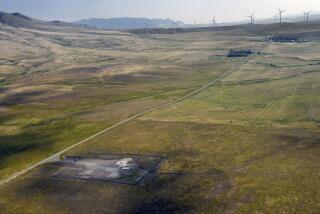U.S. May Be Checking Out Sites for Base
- Share via
SHIRKAT, Afghanistan — For more than a week, U.S. officials have been secretly touring opposition-held areas of Afghanistan including the front line north of Kabul, and may have been scouting locations for a military base.
The anti-Taliban Northern Alliance refuses to say officially how many U.S. soldiers and civilians are in the territory it controls, or what they are doing beyond assisting airstrikes against Taliban positions.
But privately, the alliance acknowledges it has been assisting U.S. officials in civilian dress here as they check on an airstrip under construction about 40 miles northeast of Kabul, the capital, and on the front lines to the south of the airfield.
Afghan guards at a huge, largely empty textile factory beside the new airstrip said in interviews Friday that two Western-looking men visited the complex Monday. It was the same day that four men in U.S.-made sportswear were spotted observing Northern Alliance military maneuvers on a hillside just down the road.
The factory would make an ideal base if U.S. ground troops were sent here. It sits on an estimated 120 acres of land with numerous large, empty warehouses. The complex is surrounded by a high stone wall, topped by barbed wire, and has guard houses at each corner.
The factory’s guards weren’t told who the men were, or the reason for their visit, but they said one spoke English. It was the first time foreigners had visited the plant since it was shut down 20 years ago, said guard Faiz Mohammed, 58, who has worked there 47 years.
“They looked around for one or two hours,” Mohammed said. “They looked at the whole place. They also filmed it.”
The guards’ description of the foreigners’ camera fit that of a pocket-sized digital video camera used by one of the observers at the military maneuvers. The men were also dressed like the observers, with sunglasses and their heads covered by Afghan scarves, the factory guards said.
U.S. bombing of Taliban positions north of Kabul has increased in recent days. After initially criticizing the U.S. bombing as too limited, Northern Alliance commanders are now praising both the scope and the accuracy of the U.S. attacks.
The U.S. is providing the Northern Alliance with military advisors on the ground and bombing from above in the hope that Afghan troops can remove the ruling Taliban regime without a large commitment of U.S. ground forces. Afghanistan has a long history of defeating foreign invaders.
But U.S. officials now appear to be laying the groundwork for troop deployments by assessing how their logistical needs could be met in a country where electricity, clean water and other basics are in short supply.
If the alliance launches an offensive and drives Taliban forces back from positions near the former Soviet air base at Bagram, it could be used by large military transports. But the alliance appears to be close to finishing the half-mile airstrip at Shirkat as insurance if Bagram can’t be made safe.
For weeks, Afghan workers have been clearing the Shirkat airstrip, which could handle flights for supplying arms and ammunition to anti-Taliban forces in a push toward Kabul.
The Northern Alliance says that when completed, it will be long enough to handle Russian and U.S.-made military transport planes, including the Hercules C-130.
But work appears to be slowed by broken equipment. A truck was seen recently pulling a heavy roller to flatten the airstrip’s surface because the proper equipment wasn’t functioning.
Local Afghan officials wouldn’t allow journalists to visit the Shirkat airstrip or the old textile factory Friday. But guards at the plant’s gate said it once employed some 12,000 workers, and has too many buildings to count.
“If you walk around for an hour, you won’t see all of them,” said Mohammed, who described the largest warehouse as an empty, high-ceiling building about 120 yards long.
A large map of the complex on an outer wall showed a grid of at least three main roads that run the length of the property, three crossroads and five side roads.
From 100 to 150 Afghans still work at the complex, mainly as guards, added Mohammed, who wondered whether the foreign visitors were planning to get the factory operating again.
In its heyday, under Soviet-backed Communist rule, the state-owned factory sent out anywhere from 12 to 20 truckloads of cotton cloth and other textiles per day for export. The machines, which were cleaned and covered in tarpaulins, would still work if they had power, materials and workers to run them, he said.
More to Read
Sign up for Essential California
The most important California stories and recommendations in your inbox every morning.
You may occasionally receive promotional content from the Los Angeles Times.













